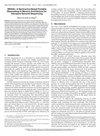RoPIM:一种加速变压器模型旋转位置嵌入的内存处理架构
IF 1.4
3区 计算机科学
Q4 COMPUTER SCIENCE, HARDWARE & ARCHITECTURE
引用次数: 0
摘要
基于注意力的Transformer模型(如GPT、BERT和LLaMA)的出现,通过显著提高各种应用程序的性能,彻底改变了自然语言处理(NLP)。推动这些改进的一个关键因素是位置嵌入的使用,这对于捕获序列中标记之间的上下文关系至关重要。然而,当前的位置嵌入方法面临着挑战,特别是在管理长序列的性能开销和有效捕获相邻标记之间的关系方面。因此,旋转位置嵌入(RoPE)作为一种有效嵌入位置信息的方法,即使是长序列,也不需要对模型进行再训练。尽管RoPE很有效,但它在推理过程中引入了相当大的性能瓶颈。我们观察到,由于大量的数据移动和执行依赖,RoPE占GPU执行时间的61%。在本文中,我们介绍了RoPIM,一种内存处理(PIM)架构,旨在有效地加速Transformer模型中的RoPE操作。RoPIM通过使用银行级加速器来实现这一目标,该加速器通过支持乘法加法操作来减少片外数据移动,并通过并行数据重排来最小化操作依赖性。此外,RoPIM提出了一种优化的数据映射策略,该策略利用银行级和行级映射来实现并行执行,消除银行间通信,并减少DRAM激活。实验结果表明,与传统系统相比,RoPIM实现了高达307.9倍的性能提升和914.1倍的节能。本文章由计算机程序翻译,如有差异,请以英文原文为准。
RoPIM: A Processing-in-Memory Architecture for Accelerating Rotary Positional Embedding in Transformer Models
The emergence of attention-based Transformer models, such as GPT, BERT, and LLaMA, has revolutionized Natural Language Processing (NLP) by significantly improving performance across a wide range of applications. A critical factor driving these improvements is the use of positional embeddings, which are crucial for capturing the contextual relationships between tokens in a sequence. However, current positional embedding methods face challenges, particularly in managing performance overhead for long sequences and effectively capturing relationships between adjacent tokens. In response, Rotary Positional Embedding (RoPE) has emerged as a method that effectively embeds positional information with high accuracy and without necessitating model retraining even with long sequences. Despite its effectiveness, RoPE introduces a considerable performance bottleneck during inference. We observe that RoPE accounts for 61% of GPU execution time due to extensive data movement and execution dependencies. In this paper, we introduce RoPIM , a Processing-In-Memory (PIM) architecture designed to efficiently accelerate RoPE operations in Transformer models. RoPIM achieves this by utilizing a bank-level accelerator that reduces off-chip data movement through in-accelerator support for multiply-addition operations and minimizes operational dependencies via parallel data rearrangement. Additionally, RoPIM proposes an optimized data mapping strategy that leverages both bank-level and row-level mappings to enable parallel execution, eliminate bank-to-bank communication, and reduce DRAM activations. Our experimental results show that RoPIM achieves up to a 307.9× performance improvement and 914.1× energy savings compared to conventional systems.
求助全文
通过发布文献求助,成功后即可免费获取论文全文。
去求助
来源期刊

IEEE Computer Architecture Letters
COMPUTER SCIENCE, HARDWARE & ARCHITECTURE-
CiteScore
4.60
自引率
4.30%
发文量
29
期刊介绍:
IEEE Computer Architecture Letters is a rigorously peer-reviewed forum for publishing early, high-impact results in the areas of uni- and multiprocessor computer systems, computer architecture, microarchitecture, workload characterization, performance evaluation and simulation techniques, and power-aware computing. Submissions are welcomed on any topic in computer architecture, especially but not limited to: microprocessor and multiprocessor systems, microarchitecture and ILP processors, workload characterization, performance evaluation and simulation techniques, compiler-hardware and operating system-hardware interactions, interconnect architectures, memory and cache systems, power and thermal issues at the architecture level, I/O architectures and techniques, independent validation of previously published results, analysis of unsuccessful techniques, domain-specific processor architectures (e.g., embedded, graphics, network, etc.), real-time and high-availability architectures, reconfigurable systems.
 求助内容:
求助内容: 应助结果提醒方式:
应助结果提醒方式:


